Description of Test
The test consists of a series of mathematics questions. The questions are presented in full in the table below.
The question format varies from item to item. Some questions require a numerical response, where the twin has to type a number in a box then click on "OK". In other questions, a set of possible responses (consisting of pictures, text or numbers) are presented on screen, and the twin has to select one or more answers. In these cases, if one answer is required then the twin simply clicks on it; if two or more answers are required, the twin clicks on the chosen responses then clicks on "OK".
The test in its original format (as used in cohort 1 only) comprised 5 sub-tests:
- Understanding number (27 items)
- Non-numerical processes (19 items)
- Computation and knowledge (31 items)
- Mathematical interpretation (33 items)
- Mathematical application (24 items)
However, sub-tests 4 and 5 were dropped after cohort 1. While the item variables from sub-tests 4 and 5 remain in the dataset, they do not contribute to the total test score, and they are not listed in the table of items below.
The items from the different sub-tests are intermingled in the test as a whole. A twin is presented with an item from sub-test 1, then an item from sub-test 2, then an item from sub-test 3, and so on. However, the branching and discontinue rules (described below) apply independently within each sub-test. Hence a twin may branch up in one sub-test while branching down in another; and a twin may continue with items from one sub-test after another sub-test has discontinued.
Test Rules
- Scoring
For each question, the correct response is given a score of 1, and any incorrect response is given a score of 0. The maximum total score for the test is 77 (this total only includes the items from sub-tests 1, 2 and 3).
If at any point in a sub-test a twin branches up, and does not subsequently branch down again, any lower items skipped due to branching (in the same sub-test) are credited towards the score, as though they had been answered correctly. - Branching rules
The branching rules apply independently within each of the sub-tests. The detailed branching rules for each sub-test are tabulated below, but the general principles of the branching are as follows:- A branch point consists of 3 selected consecutive items (in item number order) in a sub-test.
- Each sub-test has either one branch point (sub-tests 2 and 5) or two branch points (sub-tests 1, 3 and 4)
- Each sub-test starts with a branch point at an intermediate level of difficulty (National Curriculum Level 4 or 5). Sub-tests 1, 3 and 4 have an additional branch point at a higher level of difficulty (National Curriculum Level 6).
- If the three items of a branch point are all answered incorrectly, move down to a basal point at a lower level.
- If some items of a branch point are answered correctly and some incorrectly, move on to the basal point directly following the branch point.
- If all three items of a branch point are answered correctly,
then:
- For the first branch point of sub-tests 1, 3 and 4:
move up directly to the second branch point. - For the branch point of sub-tests 2 and 5, and for the
second branch point of sub-tests 1, 3 and 4:
move on to the basal point directly following the branch point.
- For the first branch point of sub-tests 1, 3 and 4:
- At a basal point, the twin proceeds upwards (in ascending order of sub-test item number) either until the end of the sub-test is reached, or until the twin discontinues the sub-test (see below).
No item is presented more than once, and no further branching occurs after a basal point has been reached. Here is an example sequence of items in sub-test 1:Sub-test Branch point items If all incorrect go to: If some correct go to: If all correct go to: 1 1401, 1402, 1403 Basal point 1101 Basal point 1404 Branch point 1601, 1602, 1603 1601, 1602, 1603 Basal point 1404 Basal point 1604 2 2501, 2502, 2503 Basal point 2101 Basal point 2504 3 3401, 3402, 3403 Basal point 3101 Basal point 3404 Branch point 3601, 3602, 3603 3601, 3602, 3603 Basal point 3404 Basal point 3604 4 4401, 4402, 4403 Basal point 4101 Basal point 4404 Branch point 4601, 4602, 4603 4601, 4602, 4603 Basal point 4404 Basal point 4701 5 5501, 5502, 5503 Basal point 5101 Basal point 5504
1401, 1402, 1403 (branch up), then 1601, 1602, 1603 (branch down), then 1404 upwards (omitting 1601-1603 as already attempted) until discontinuing; items 1101 up to 1304 are credited because they were skipped due to upward branching. - Discontinue rules
Discontinue the sub-test after three consecutive items are answered incorrectly (with zero score). Note that this rule does not apply to the first three sub-test items (in the first branch point). The discontinue rule applies after a basal point has been reached, or after the second branch point has been reached in sub-test 1, 3 or 4.
The discontinue rule applies independently within each sub-test. Hence one sub-test may discontinue while the other sub-tests continue. - Timeout rule
A timeout of 5 minutes applies to each item. After 5 minutes with no response, the item is forfeited with zero score, and a "next item" screen appears. On resuming the test, the twin is taken to the next item in sequence as described above.
Item Variables
The item variables relating to the Maths test, as listed in the table below, were generated automatically by programs on the web server during the course of the test. Note that the dataset only includes data for completed tests. If a twin started the test but left it unfinished, then the data for the test were not used.
The values of some of these variables have been left unaltered, although some have been recoded during data cleaning. See the web data cleaning page for further details.
- Item response variables have been recoded from raw strings into numeric categories as follows: 1=correct response; 2=valid but incorrect response; 9=empty response. An 'empty' response may occur in certain items where a twin has clicked the OK button to continue without actually inputting a valid answer to the question.
- For timed out items, the item response variable is recoded from an empty string to '-1', and the item answer time is recoded from 300 to missing (item scores are 0)
- For items skipped due to the discontinue rule, the item response variable is recoded from an empty string to '-2', and the item score is recoded from missing to 0.
- For items skipped and credited due to upward branching, the item response variable is recoded from an empty string to '-3', and item scores are recoded from missing to 1.
- For items that crashed or malfunctioned in any way, the item response variable is recoded from an empty string to '-4', and the item score is recoded from missing to 0.
- For twins identified as random responders in this test, the status flag is recoded from 2 to 4, the data flag is recoded from 1 to 0, and all item variables are recoded to missing (test data deleted)
The test start and end dates and times, and item answer and download times, and item orders, have not been retained in the dataset.
| Variables | Explanation | Values |
|---|---|---|
| jmstat1/2 | Test status: outcome of test | 0=not started, 1=started but not finished, 2=successfully completed, 4=random responses |
| jmdata1/2 | Data flag: are test data present in the dataset? | 0=no, 1=yes |
| jmstdt1/2 | Start date of the test [not in dataset] | Date values |
| jmsttm1/2 | Start time of the test [not in dataset] | Time values |
| jmenddt1/2 | End date of the test [not in dataset] | Date values |
| jmendtm1/2 | End time of the test [not in dataset] | Time values |
| jmsess1/2 | Number of sessions (at the computer) used by the twin to complete the test. | Integer values of 1 or above |
| jmtime1/2 | Time taken to complete the test, in seconds | Integer values (number of seconds) |
| jmXXXXa1/2 (XXXX is the item number, as tabulated below) |
Item response code. | 1=correct response, 2=valid but incorrect response, 9=empty response, -1=item timed out, -2=discontinued, -3=credited due to upward branching, -4=item crashed. |
| jmXXXXs1/2 (XXXX is the item number, as tabulated below) |
Item score (see table of items below for details) | 0=incorrect, 1=correct |
| jmXXXXt1/2 (XXXX is the item number, as tabulated below) |
Answer time: length of time (in seconds) taken by the twin to respond to this item [not in dataset] | Integer values (number of seconds) |
| jmXXXXd1/2 (XXXX is the item number, as tabulated below) |
Download time: length of time (in seconds) between the end of the previous item and the start of this item; time needed to download files for this item [not in dataset] | Integer values (number of seconds) |
| jmXXXXo1/2 (XXXX is the item number, as tabulated below) |
Order or sequence of this item in the test; dependent on the branching path taken by the twin through this test [not in dataset] | Integer values of 1 or above |
Item numbering and item references
This section explains the meaning of the item numbers and reference numbers, which are shown in the first two columns of the table of items below. The item numbers are also incorporated into the item variable names, as described above.
Each item number comprises 4 digits, of the form ABCC as follows:
- A (first digit): this identifies the sub-test (1, 2, 3, 4 or 5).
- B (second digit): this identifies the National Curriculum Level of the item, according to the NFER booklets from which the items were taken. The levels are 1, 2, 3, 4, 5, 6 and 7. The higher the level, the greater the difficulty of the question.
- CC (third and fourth digits): these are arbitrary sequence numbers, to distinguish between items in the same sub-test and at the same National Curriculum Level.
The reference numbers shown in the table below can be used to identify the NFER booklet items that were used for this test (see the 10 year measures page for full details of the booklets used). Each reference has the form YY-ZZ as follows:
- YY is the NFER booklet number: 6, 7, 8, 9, 10 or 11
- ZZ is the item number within the given booklet. These item numbers range from 1 to roughly 50.
Test Items
Note that this table only shows items from sub-tests 1, 2 and 3. These three sub-tests were included in the Maths test for all cohorts of the 10 Year study. The total score for the test (out of 77) is the sum of the scores for these items.
Sub-tests 4 and 5 were only used in cohort 1 of the 10 year study. They were then dropped from the test. Details of items of sub-tests 4 and 5 are not included in the table below, although their item numbers are listed for reference.
Note that the last column shows the coding of string responses in the raw data, which differs from the numeric category coding in the dataset response variables (see above).
| Item no. | Ref. | Item text | Picture | Correct response | Raw response coding |
|---|---|---|---|---|---|
| 1101 | 7-7 | This is a number pattern. Type the next three numbers in the boxes. 4 , 4 , 3 , 4 , 4 , 3 , 4 , __ , __ , __ | (no picture) | need all 3 answers in the correct sequence: 4, 3, 4 | numbers as entered |
| 1201 | 7-3 | Find two odd numbers that add up to 8. Type these numbers in the boxes. Remember, both numbers must be odd. | (no picture) | one of the following: 1 + 7, 7 + 1, 3 + 5, 5 + 3 | numbers as entered |
| 1202 | 7-16 | One of these squares has one quarter coloured
orange. Click on it. | 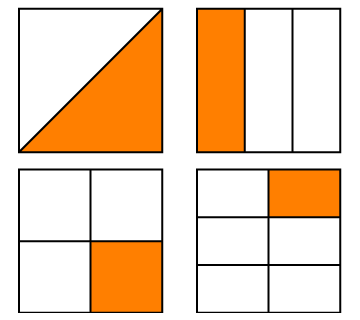 |
the bottom-left shape (3rd option) | shapes coded 1, 2, 3, 4 (top-left to bottom-right) |
| 1203 | 9-41 | Type these numbers in the boxes in order,
starting with the smallest. 60, 16, 6, 66, 36 | (no picture) | need all 5 correct, in the right order: 6, 16, 36, 60, 66 | numbers as entered |
| 1301 | 8-16 | Look at this number pattern. Type the missing numbers in the boxes. __ , __ , 9, 12, 15, 18 | (no picture) | need both correct, in the right order: 3, 6 | numbers as entered |
| 1302 | 8-17 | Type in the box the figures for the number two hundred and fifty two. | (no picture) | 252 | number as entered |
| 1303 | 8-32 | Look at the numbers. Find the number that is closest to 77 and click on it. | 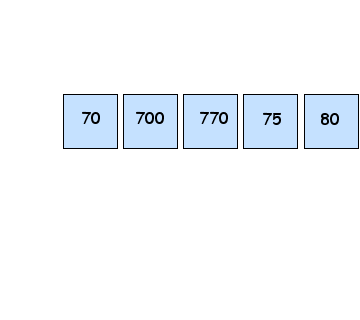 |
75 (4th option) | response boxes coded 8, 9, 10, 11, 12 (left to right) |
| 1304 | 9-1 | Type in the three missing numbers in this
pattern. __ , 10, 15, __ , __ , 30, 35 | (no picture) | need all 3 correct, in the right order: 5, 20, 25 | numbers as entered |
| 1401 | 8-8 | A girl was born on the 8th of April 1980. How old was she on the 8th April 1993? Type in the answer. | (no picture) | 13 | number as entered |
| 1402 | 9-38 | What fraction of the shape is shaded? Click on the answer. | 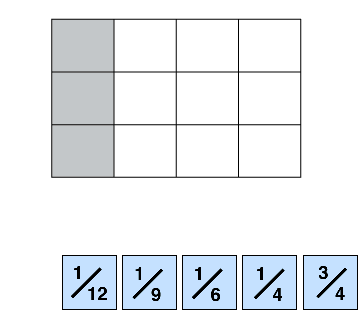 |
¼ (one quarter) | response boxes coded 20, 21, 22, 23, 24 (left to right) |
| 1403 | 8-34 | You are going to break this bar of chocolate
into four quarters. How many squares will there be in each quarter? Type in the answer. | 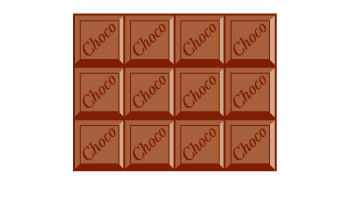 | 3 | number as entered |
| 1404 | 9-28 | Click on the correct answer. 27 to the nearest 10 is__ | 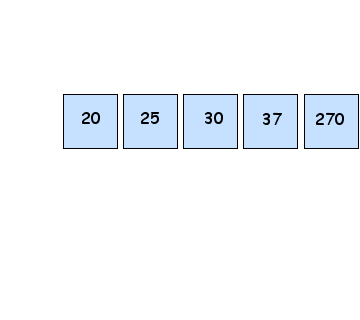 |
30 (3rd option) | response boxes coded 8, 9, 10, 11, 12 (left to right) |
| 1501 | 8-23 | Work out the answers and type them in the
boxes. 7 x 100 = __ 14 x 100 = __ 37 x 100 = __ | (no picture) | need all 3 correct, in the right order: 700, 1400, 3700 | numbers as entered |
| 1502 | 8-28 | Type the missing number in the box. 15 x 6 = 90 __ x 6 = 96 | (no picture) | 16 | number as entered |
| 1503 | 9-16 | Look at the number 6085. Change the order of the figures around to make the biggest number possible. Type in the answer. | (no picture) | 8650 | number as entered |
| 1504 | 10-16 | Fill in the missing numbers by typing in the
boxes. __ + 1 = 11 __ - 1 = 11 __ x 1 = 11 | (no picture) | need all 3 correct, in this order: 10, 12, 11 | numbers as entered |
| 1505 | 10-19 | Which of these lengths is closest to the
length of a real bath? Click on it. | 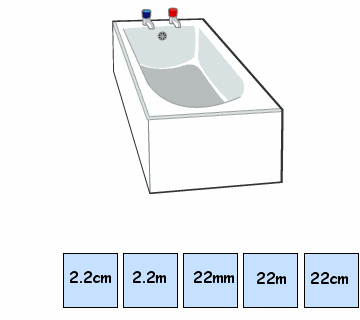 |
2.2m (2nd option) | response boxes coded 20, 21, 22, 23, 24 (left to right) |
| 1506 | 10-24 | Type 17, 36 and 612 in the correct boxes. |  |
either of these two correct sequences: 612, 17, 36 or 612, 36, 17 | numbers as entered |
| 1507 | 10-29 | Click on the box in which the times are in the order that they occur in a day. | 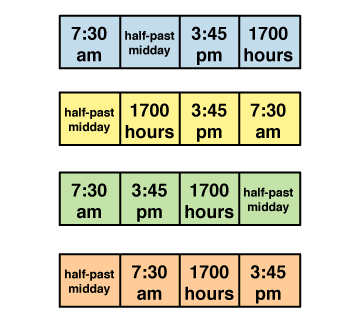 |
the top (1st) option | response boxes coded 1, 2, 3, 4 (top to bottom) |
| 1601 | 8-31 | Type the missing number in the box. 27 + 27 + 27 + 27 + 27 = 27 x ___ | (no picture) | 5 | number as entered |
| 1602 | 9-11 | The first machine multiplies all numbers by 6. The second machine changes them all back again. Click on what the second machine does. | 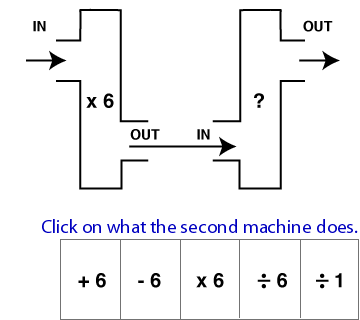 |
÷6 [divide by 6] (4th option) | response boxes coded 20, 21, 22, 23, 24 (left to right) |
| 1603 | 9-17 | Estimate how much orange juice there is in
this jug. Give your answer in millilitres. Type in the answer | 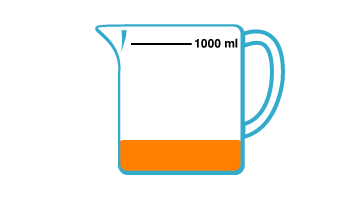 | any number in the range 230 to 340 | number as entered |
| 1604 | 11-36 | Type the correct number in each box. | 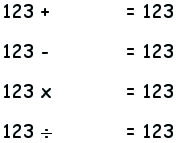 |
need all four correct: 0, 0, 1, 1 | numbers as entered |
| 1701 | 10-39 | This shows part of a tape measure. What length is marked by the arrow, in metres? Click on the answer. | 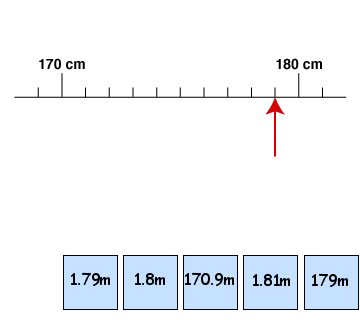 |
1.79m (1st option) | response boxes coded 20, 21, 22, 23, 24 (left to right) |
| 1702 | 11-30 | Type in the answer. 1.25 x 100 = ___ | (no picture) | 125 | number as entered |
| 1703 | 11-44 | These three numbers are alike in some ways: 9, 36, 81. Click on the two ways in which they are alike. | 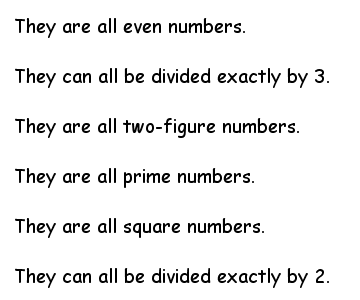 |
Need both correct: They can all be divided exactly by 3 (2nd option), They are all square numbers (5th option) | response options coded 1, 2, 3, 4, 5, 6 (top to bottom) |
| 1704 | 11-47 | What fraction of this circle is shaded? Click on the answer. | 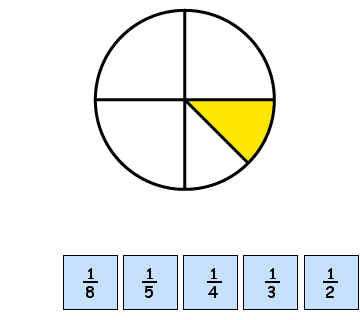 |
1/8 [one eighth] (1st option) | response boxes coded 20, 21, 22, 23, 24 (left to right) |
| 2101 | 7-1 | Which is the longest drinking straw? Click it. | 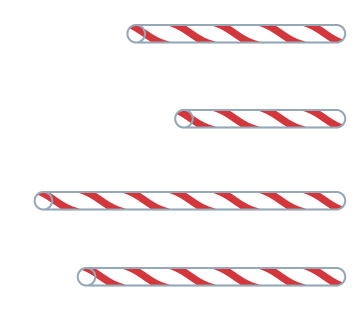 | 3rd straw down from the top | pictures coded 1, 2, 3, 4 (top to bottom) |
| 2201 | 6-4 | One of these shapes has four corners that are
the same. Click on this shape. | 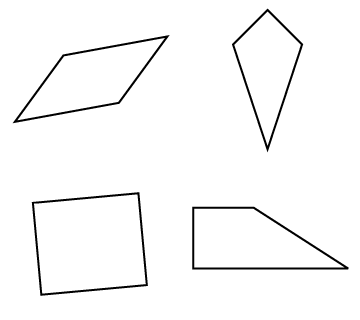 | the bottom-left shape (rectangle) | pictures coded 1, 2, 3, 4 (top-left to bottom-right) |
| 2202 | 6-9 | One of these shapes does not have three sides. Click on this shape. | 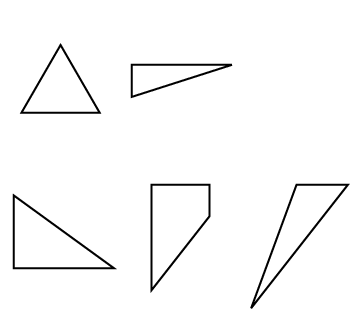 | the middle-bottom shape | pictures coded left to right: 1, 2 (top row) and 4, 5, 6 (bottom row) |
| 2203 | 8-4 | This man is walking along a path. When he comes to the letter B, he turns right and walks a little further. Which letter does he come to? Click on it. | 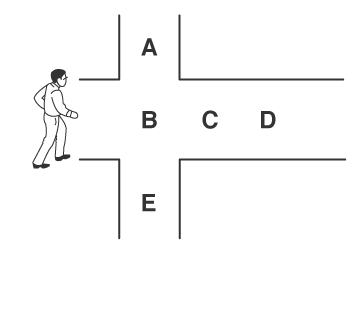 |
E (bottom of diagram) | responses coded 3=A, 9=B, 10=C, 11=D, 15=E |
| 2204 | 9-3 | Click on each shape that has only 1 curved side and 2 straight sides. | 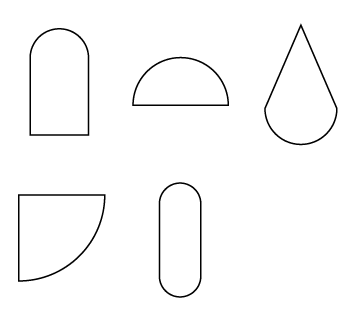 |
need both correct: the top-right and bottom-left shapes (3rd and 4th options) | pictures coded 1, 2, 3, 4, 5 (top-left to bottom-right) |
| 2301 | 9-45 | Click on the shape with the largest number of right-angled corners. | 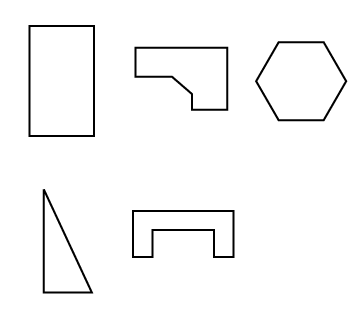 |
the bottom-middle shape (5th option) | pictures coded 1, 2, 3, 4, 5 (top-left to bottom-right) |
| 2501 | 10-26 | Which card appears the same when turned
upside down? Click on it. | 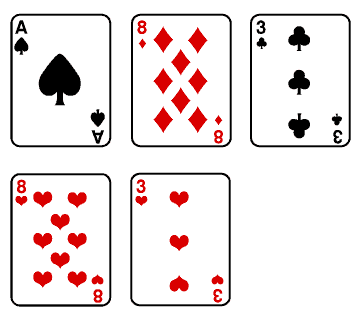 |
8 of diamonds (top-middle picture) | pictures coded 1, 2, 3, 4, 5 (top-left to bottom-right) |
| 2502 | 9-23 | The picture below shows half of a symmetrical
pattern. Click on the picture opposite which shows the other half of the pattern. 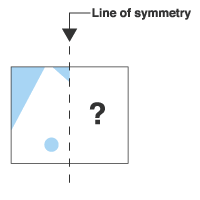 |
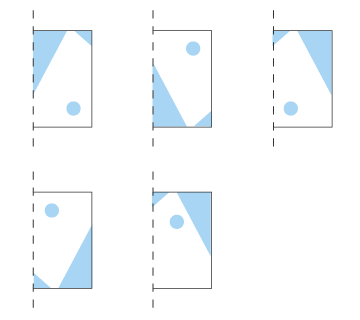 |
the top-right picture (3rd option) | pictures coded 1, 2, 3, 4, 5 (top-left to bottom-right) |
| 2503 | 8-9 | I start at the place marked with an A and walk
South-West. Click on the number I come to. | 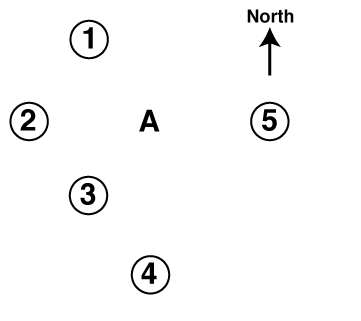 | 3 | responses coded 2=1, 7=2, 14=3, 21=4, 11=5 |
| 2504 | 11-31 | These shapes are alike in some ways. Click on 2 ways in which they are alike. | 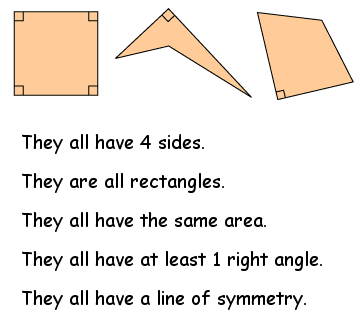 |
need both correct: they all have 4 sides (1st option), they all have at least 1 right angle (4th option) | responses coded 4, 5, 6, 7, 8 (top to bottom) |
| 2505 | 11-40 | Three corners of a square are found at P
(4,5), Q (2,3), R (4,1). Where is the fourth corner? Type in the answer. | 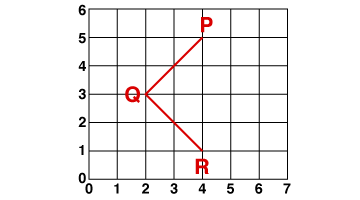 |
Need both correct, in the right sequence: (6, 3) | numbers as entered |
| 2601 | 8-18 | The letter E is turned clockwise through one
right angle. Click on the answer. | 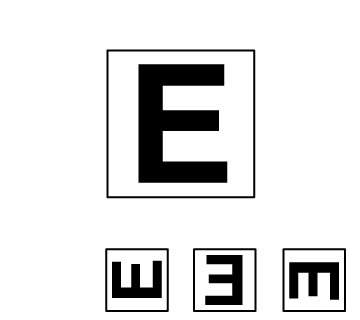 | the bottom-right (3rd) option | pictures coded 14, 15, 16 (left to right) |
| 2602 | 8-30 | Look at the four different kinds of shapes. Imagine fitting shapes of the same kind together. Without leaving gaps, which of these shapes will fit together with shapes of the same kind? Click on the shape(s). There may be more than one. | 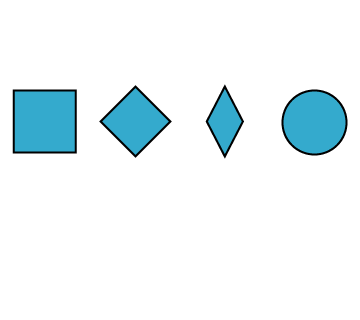 |
need all 3 correct: 1st, 2nd and 3rd options | pictures coded 5, 6, 7, 8 (left to right) |
| 2603 | 9-15 | Click on the reflection of this shape. | 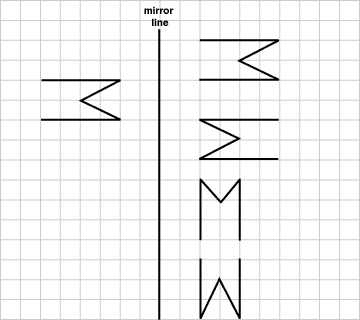 | the 2nd shape from the top | grid references from picture: top shape is 15, 16, second picture is 33, 34, third picture is 51, bottom picture is 60, 69 |
| 2604 | 9-27 | Click on the 2 shapes that have the same area. | 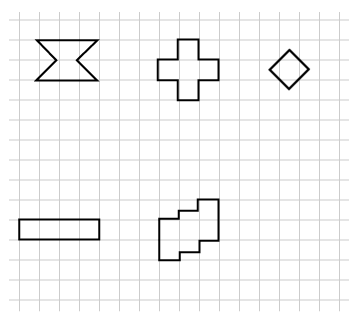 |
need both correct: the top-left (1st) shape, the bottom-left (4th) shape | pictures coded 1, 2, 3, 4, 5 (top-left to bottom-right) |
| 2605 | 9-33 | The shape below is about to turn 3 right
angles anticlockwise. Click on where the dot will be on the shape opposite. 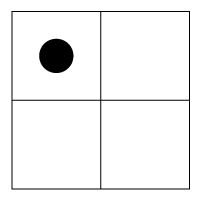 |
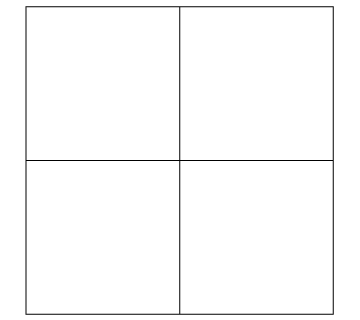 | the top-right square | pictures coded 1, 2, 3, 4 (top-left to bottom-right) |
| 2606 | 11-42 | Which of these shows a reflection? Click on it. | 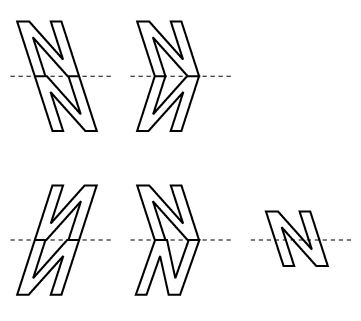 |
the top-right pattern (2nd option) | pictures coded left to right: 1, 2 (top row) and 4, 5, 6 (bottom row) |
| 2701 | 11-35 | Mark all the angles that are equal to X. Click on the arrows in the picture that point at the angles you think are the same as X. | 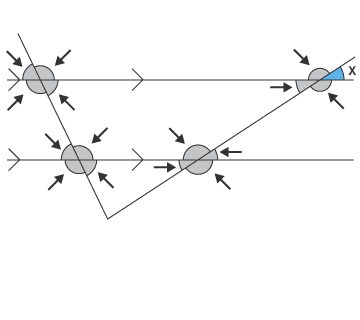 |
need all three answers: the angle directly opposite X, and the two acute angles in the bottom-right corner | grid references from the picture; the three correct responses are coded 26, 33, 41 |
| 2801 | 10-35 | A man walked around this building. He drew a sketch at each point. What point was he at when he drew these sketches? Click on the correct letter for each sketch 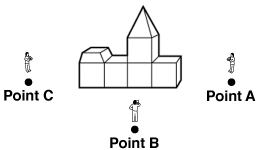 |
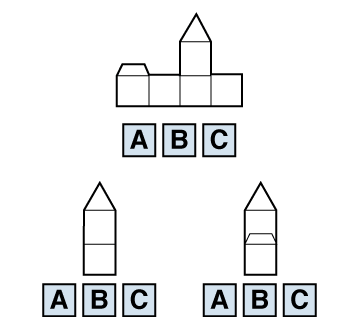 |
need all three answers: B (top diagram), A (bottom left), C (bottom right) | grid references from the picture; the three correct responses are coded 32, 65, 71 |
| 3101 | 6-2 | Click on the shape which is below the square. | 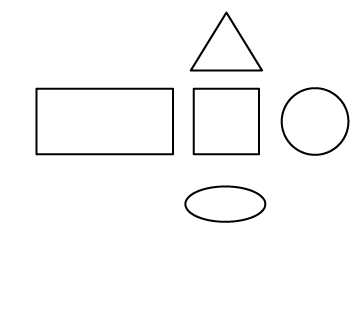 | the oval shape at the bottom | pictures are coded top to bottom and left to right: 3, 6, 7, 8, 11 |
| 3201 | 6-5 | Double each of the numbers and type your answers in the boxes. |  |
need all 3 correct, in this order: 4, 6, 8 | numbers as entered |
| 3202 | 6-18 | Work out the answer and type it in the box. 6 - 2 = __ | (no picture) | 4 | number as entered |
| 3203 | 8-5 | Click on each even number and then click on the OK button. | 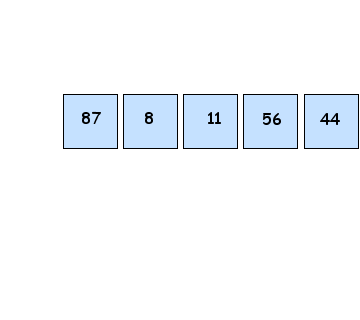 |
need all 3 correct: 8, 56, 44 (2nd, 4th and 5th options) | response boxes coded 8, 9, 10, 11, 12 (left to right) |
| 3204 | 9-2 | Natalie had 8 biscuits. She gave 6 to her friends. How many did she have left? Type in the answer. | (no picture) | 2 | number as entered |
| 3205 | 9-32 | Click on each of the even numbers in the box. | 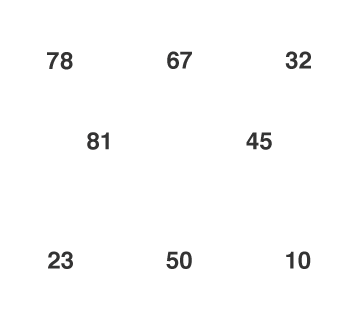 |
need all 4 correct: 78 (top-left), 32 (top-right), 50 (bottom-middle), 10 (bottom-right) | grid references from picture; correct responses include 1, 5, 6,11, 17, 59, 62 (but it is not clear which parts of the picture these relate to) |
| 3301 | 8-2 | 30p has to be shared equally between 3
children. How much will each child receive? Type in the answer. | (no picture) | 10 | number as entered |
| 3302 | 9-9 | Tapes cost £7 each. How much do 5 tapes cost? Type in the answer. | (no picture) | 35 | number as entered |
| 3303 | 9-19 | What is the difference in price? Type in the answer. | 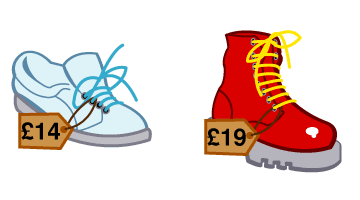 | 5 | number as entered |
| 3401 | 8-7 | Look at this picture of Leon and Emma. What is the difference in height? Type in the answer. | 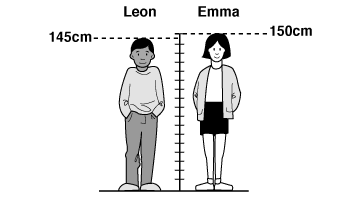 | 5 | number as entered |
| 3402 | 9-4 | Mira sorts her money into piles. She has: four £1 coins, two 10p coins and five 2p coins. How much money does she have altogether? Click the answer. | 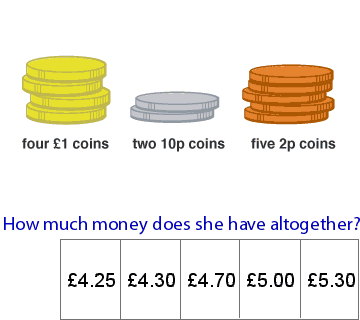 |
£4.30 (2nd option) | response boxes coded 20, 21, 22, 23, 24 (left to right) |
| 3403 | 8-11 | What is the total cost of 6 books that cost £7 each? Type in the answer. | (no picture) | 42 | number as entered |
| 3404 | 8-15 | What number is 3 less than 200? Type in the answer. | (no picture) | 197 | number as entered |
| 3405 | 8-19 | Work out the answer to this sum and type it in
the box. 64 + 905 = __ | (no picture) | 969 | number as entered |
| 3406 | 8-35 | One of these numbers can be divided exactly by
five. Click on it. | 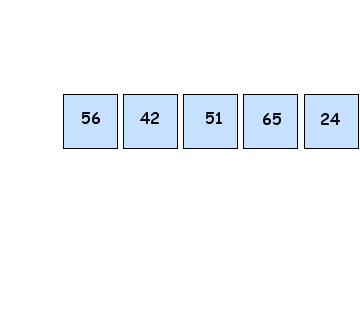 |
65 (4th option) | response boxes coded 8, 9, 10, 11, 12 (left to right) |
| 3407 | 9-14 | Click on the hexagon. | 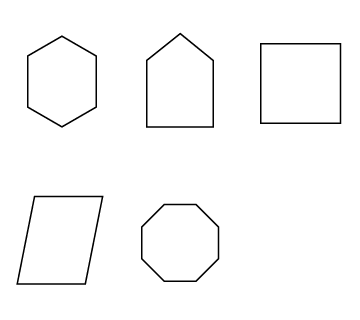 |
the top-left shape (1st option) | pictures coded 1, 2, 3, 4, 5 (top-left to bottom-right) |
| 3408 | 9-30 | What is the total of 680 and 192? Type in the answer. | (no picture) | 872 | number as entered |
| 3501 | 9-6 | Type in the answer. 76 - 39 = __ | (no picture) | 37 | number as entered |
| 3502 | 10-18 | Type in the answer. 563 + 797 = __ | (no picture) | 1360 | number as entered |
| 3503 | 11-21 | Type in the answer. 149 + 785 = __ | (no picture) | 934 | number as entered |
| 3504 | 11-23 | Click on the time that is the same as 4:25 pm. | 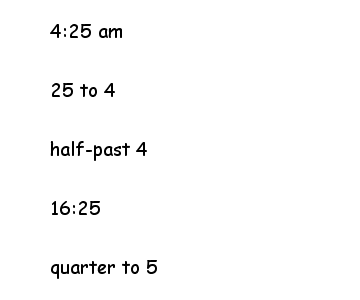 |
16:25 (the 4th option) | responses coded 1, 2, 3, 4, 5 (top to bottom) |
| 3505 | 11-43 | Which of these is not a quadrilateral? Click on it. | 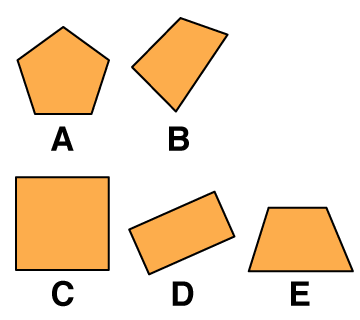 |
A (the 1st, top-left shape) | pictures coded left to right: 1, 2 (top row) and 4, 5, 6 (bottom row) |
| 3506 | 11-50 | What is the total cost of 8 books that cost
£9 each? Type in the answer. | (no picture) | 72 | number as entered |
| 3601 | 8-14 | Type in the answer. 47 x 2 = ___ | (no picture) | 94 | number as entered |
| 3602 | 9-40 | Type in the answer. |  | 23 | number as entered |
| 3603 | 9-44 | 84 stamps are shared equally between 6
children. How many stamps will each child have? Type in the answer. | (no picture) | 14 | number as entered |
| 3604 | 10-27 | Jodie is making a model aeroplane. It takes her 1¼ hours to stick it together, and then ½ an hour to paint it. How long has it taken altogether? Click on the answer. | 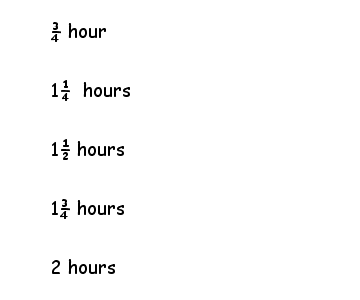 |
1 ¾ hours [one and three quarter hours] (4th option) | responses coded 1, 2, 3, 4, 5 (top to bottom) |
| 3605 | 10-30 | All 4-sided shapes are called…? Click on the correct answer. | 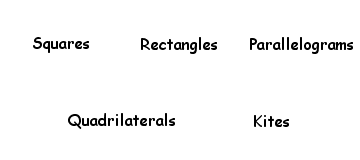 | quadrilaterals | grid references from picture; responses for the correct answer are 8, 9 |
| 3701 | 10-21 | Click on all the acute angles. | 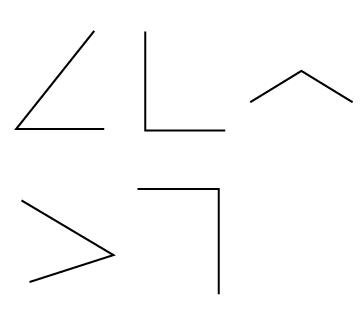 |
need both correct: top-left, bottom-left angles | pictures coded 1, 2, 3, 4, 5 (top-left to bottom-right) |
| 3702 | 10-41 | Type in the answer. |  | 54 | number as entered |
| 3703 | 11-49 | Which of these give the same answer? Click on them. | 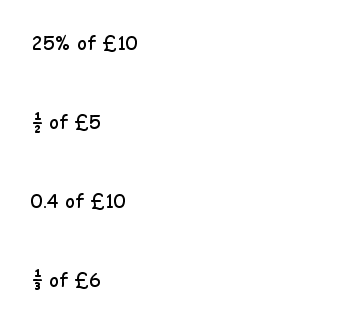 |
need both correct answers: 25% of £10 (1st option), ½ of £5 (2nd option) | responses coded 1, 2, 3, 4 (top to bottom) |
| 4101 | (details not available) | ||||
| 4201 | (details not available) | ||||
| 4202 | (details not available) | ||||
| 4203 | (details not available) | ||||
| 4301 | (details not available) | ||||
| 4302 | (details not available) | ||||
| 4303 | (details not available) | ||||
| 4304 | (details not available) | ||||
| 4305 | (details not available) | ||||
| 4306 | (details not available) | ||||
| 4307 | (details not available) | ||||
| 4308 | (details not available) | ||||
| 4309 | (details not available) | ||||
| 4310 | (details not available) | ||||
| 4311 | (details not available) | ||||
| 4401 | (details not available) | ||||
| 4402 | (details not available) | ||||
| 4403 | (details not available) | ||||
| 4404 | (details not available) | ||||
| 4405 | (details not available) | ||||
| 4406 | (details not available) | ||||
| 4407 | (details not available) | ||||
| 4408 | (details not available) | ||||
| 4409 | (details not available) | ||||
| 4410 | (details not available) | ||||
| 4411 | (details not available) | ||||
| 4501 | (details not available) | ||||
| 4502 | (details not available) | ||||
| 4601 | (details not available) | ||||
| 4602 | (details not available) | ||||
| 4603 | (details not available) | ||||
| 4701 | (details not available) | ||||
| 4702 | (details not available) | ||||
| 5101 | (details not available) | ||||
| 5201 | (details not available) | ||||
| 5202 | (details not available) | ||||
| 5301 | (details not available) | ||||
| 5302 | (details not available) | ||||
| 5401 | (details not available) | ||||
| 5402 | (details not available) | ||||
| 5501 | (details not available) | ||||
| 5502 | (details not available) | ||||
| 5503 | (details not available) | ||||
| 5504 | (details not available) | ||||
| 5505 | (details not available) | ||||
| 5506 | (details not available) | ||||
| 5601 | (details not available) | ||||
| 5602 | (details not available) | ||||
| 5603 | (details not available) | ||||
| 5604 | (details not available) | ||||
| 5701 | (details not available) | ||||
| 5702 | (details not available) | ||||
| 5703 | (details not available) | ||||
| 5704 | (details not available) | ||||
| 5705 | (details not available) | ||||
| 5706 | (details not available) | ||||
| 5707 | (details not available) | ||||